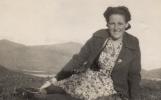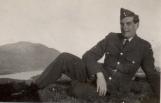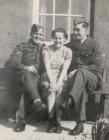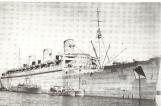1
Joan Stuart (nee Morrison)- War BrideJoan Morrison was born on October 25, 1925 in the fishing community of Leverburgh, Isle of Harris, in the Outer Hebrides, which is just off the north west coast of Scotland. Her father Samuel was a building contractor, and her mother prepared and wove yarn into Harris tweed, which was sold internationally. One of Joan's chores as a young girl was to scrape "crottal", a type of lichen, off rocks to use as an orange-brown dye in the yarn. Joan was raised to be fluent in both Gaelic and English, since both were spoken commonly in the Scotland of her childhood. Joan and her two brothers and sister attended school in Leverburgh until they reached the equivalent of grade seven, when they switched to schools on the mainland. Joan's older brother and sister completed their schooling, and when she was 13 Joan received a scholarship and went away to school in Inverness. However, two days before her 15th birthday Joan's father died, so Joan returned home, for both financial and personal reasons: her mother was in poor health. At that point, World War Two had just begun, and times were particularly hard what with all the men being away either at sea or at war and rationing in effect. However, one good thing emerged from the war: Joan met her future husband, Robert Stuart of Innisfail, Alberta.
In Leverburgh, the wife of a retired British colonel set up a Women's Volunteer service, and since there was no way of doing laundry on the base in Rodel, Harris, about four miles from Joan's home, each woman in the area was assigned to do one man's laundry for him. Joan's mother was assigned Bob Stuart, and he would have to walk the four miles one day to drop off his laundry and return the next to pick it up. Joan's mother grew quite fond of Bob, who had Scottish heritage, and often invited him for tea and scones, and wasted no time in introducing him to her daughter. Joan and Bob soon began a wartime courtship, which involved a lot of walking to and from the military base, especially for Bob.
4
In late 1942, Bob and Joan were engaged, and they were wed on February 22, 1943. It was a very small wedding, and a minister had to be picked up by taxi from a town twenty miles away to marry the couple. A fruitcake Bob's mother had sent from Canada for Christmas was used as the wedding cake; it had been saved especially for the grand occasion. The couple took a three-hour bus ride to Stornoway after the ceremony and reception, dropping off the minister in his hometown on their way. They boarded a steamer at Stornoway, and took the six hour journey to the mainland (England) then proceeded to London for their honeymoon, stopping by to visit Bob's uncle along the way. While in London, the couple did a lot of sight-seeing since it was Joan's first time to England, as well as file the necessary papers to register Joan as a Canadian war bride and insure her transport to Canada after the war, as well as guarantee her a part of his wages.After their honeymoon, Bob and Joan returned to Harris and were surprised to learn that the Canadian soldiers stationed at the base there had been rotated out and replaced by British military personnel. The Canadians had been reassigned to various other bases, many overseas, but Bob was lucky in that he was restationed on the island; however, he was now a five hour bus ride away from his new wife, and the two were only able to see each other when Bob had leave, which was about once every three months. Joan continued to live with her mother and younger brother in Harris, and on November 24, 1943 the couples' first son was born. Bob had planned in advance to take his leave around the time of the birth, so he was present for the monumental event. Joan and her young son continued to live with her family, and the boy was raised to speak both Gaelic and English, so he was able to communicate with the neighbours, his mother's family, and his father.
In May of 1945 the Second World War came to an end, and the radar stations in Britain were deactivated because of the lack of threat. Bob was sent to Torquay, England, to await his repatriation to Canada, and returned home on the "Samaria" in the latter part of 1945. His return home was much more dignified than his trip over had been: Bob had been promoted to sergeant and lodged in a bunk in a cabin in place of the hammock he had slept in on his way to battle. When he returned to Canada, he started farming again with his father on the family farm, and he and his father converted the house into a duplex while they awaited Joan.
6
Even before they were married, Joan had known that after the war ended she would have to move to Canada with her husband, but no one had known when that would be. She was one of the lucky war brides in that her husband was repatriated before she moved to Canada, so she didn't have to meet her in-laws on her own. In June 1946, she received notification that she was to report to London in a few days time to leave for Canada. She packed her allocated trunk and two suitcases with clothing, bedding, and items for her baby. Joan would have had greater difficulty leaving her mother if her sister, a war nurse who had been serving in India, hadn't returned to Harris right around the time Joan was leaving for Canada. Joan's family traveled to Stornoway to see her off, and her younger brother went with her all the way to London. The train carrying her to London passed by the train her older brother, who was returning home from Germany, was aboard, but neither knew it at the time; they didn't see each other for another eight years. Her train reached Euston Station in London, where Joan was met by "an SP in a red arm band" who escorted her to a house in Park Lane. She waited there for a few days, then boarded the "Queen Mary", headed for Halifax. Most of the passengers on the old war ship were war brides, but there was one very esteemed gentleman aboard: Canada's then prime minister, Mackenzie King, was returning home from a London conference, and Joan remembers that he gave the war brides a special speech welcoming them to Canada. Joan also remembers a time when she and her son were seated on the end of an aisle, and the Prime Minister placed his hand on the head of her son as he passed by.Upon the arrival of the Queen Mary in Halifax, planes flew out to greet the ship and they were met by a band on the pier of the port. Joan and her son were forced to remain in Halifax for a while since her son had come down with a chest ailment on the voyage, and they boarded at a Salvation Army hostel where a major of some kind notified Bob that Joan and their son were temporarily delayed. Joan was actually kind of glad that she missed the train carrying all the other war brides west, because that way she didn't have to deal with the many small children traveling with their mothers, and she could travel as just an ordinary passenger. On the way across the country, Joan refused to get off at any of the stops for fear of being left behind. She was unused to the flat plains of the prairies; it was a marked difference from the hills of her childhood. Joan and her son arrived in Calgary on June 23, 1946, where they were met by Bob and a Red Cross representative who provided a toy for the young boy. That same day they traveled to Innisfail by train where they were met by Bob's parents, sister, his sister's husband, and two uncles.
8
A picture of the ship Joan and her son traveled to Canada aboard.9
Joan found life in Alberta to be fairly similar to the life she was used to in Scotland. In both places there was no electricity, cooking and heating was done using wood (which was very similar to peat), and lighting was provided by Coleman lamp. There was one family mishap that stuck with Joan over the years though: on her first morning in Canada, she came across a cup of yeast that Bob's mother had prepared in the warming oven. Joan threw it out, thinking it was some foodstuff that had gone bad; she had never used yeast back home in Scotland, since bread was always bought at the store. Despite this mistake, Joan was still welcomed into the family.After Joan and Bob settled into their life of farming in Alberta, they had two more children: a daughter in 1948 and another son in 1955. Although Joan did not have the support network of family that she had left behind in Scotland, she did develop friendships with her new neighbours and found companionship with them. In an attempt to better adapt to her Canadian surroundings, Joan (despite protests from her eldest son, who had tried in the past few years to relearn the language) stopped speaking Gaelic completely. However, she remained fluent in the language and was able to converse in it whenever it was necessary. After moving to Canada, Joan saw her mother only one more time, when in 1954 she and her son (aged 10) and daughter (aged six) made the trip by boat and train to England and Scotland. She didn't make another trip to her homeland until 1969, but by then her mother had passed away. After her children grew up, Joan and her husband made several more trips to Britain. Joan and Bob lived on the family farm near Innisfail until 1995 when they retired and moved to town. In 2000, Bob's failing health forced him to move into the Rosefield extended care centre in Innisfail. In 2002, Joan moved into the Autumn Glen lodge. In August of that same year, Bob passed away. Currently, Joan is living in the Rosefield Centre where her husband was before his death.



